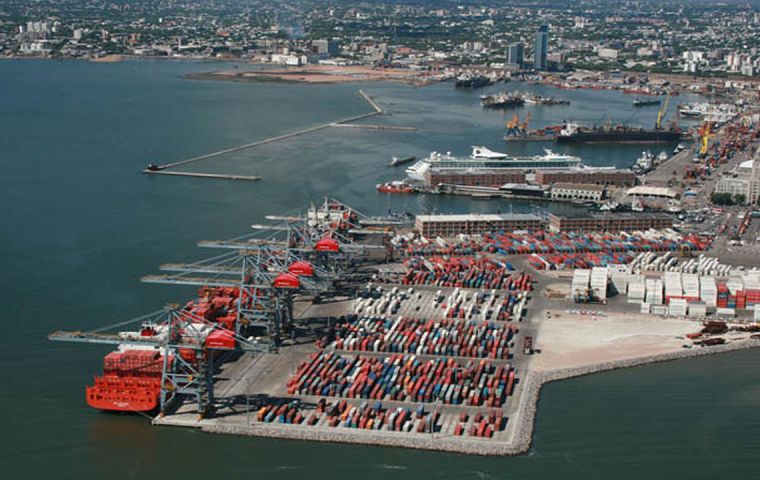MercoPress. South Atlantic News Agency
Uruguayan exports fall but 2023 still a good year
 Montevideo's port expects to handle even more trade in 2024, Curbelo explained
Montevideo's port expects to handle even more trade in 2024, Curbelo explained Uruguay's sales abroad dropped 13% interannually, according to a study released this week in Montevideo. Uruguay XXI's Annual Uruguay Trade Report showed that “neither the external nor the internal context contributed to Uruguayan exports of goods.” Uruguay XXI also noted that despite the fall from 2022 figures, 2023 was “the second year with the highest value exports in the last decade.”
“The meager growth of developed economies, the lower demand from China, and the fall in the price of commodities configured a complex external scenario,” the document elaborated.
“If we add to this the internal factors such as the unprecedented drought that the country went through and that damaged agricultural production -which has a considerable weight in the exports of goods- we obtain the aforementioned decrease”, it added.
The main items exported were beef, cellulose, dairy products, beverage concentrate, and rice. Livestock and cellulose recorded the highest positive impact, while soybean and beef accounted for most of the drop.
The main destination of Uruguayan exports was China with 22% of the share, followed by Brazil's 19% and the European Union's 16%. The United States and Argentina accounted for 8% and 5%, respectively.
Imports of goods -excluding oil, derivatives, and energy- totaled a 2% drop from 2022, mainly from a reduction in intermediate goods.
In 2020 and amid the Covid-19 pandemic, there was a 13% drop in Uruguayan exports but the South American country bounced back the following year with a 37% growth; followed by a 22% increase in 2022.
In 2023, beef exports fell 19% from 2022. Although China bought less in 2023, it remained the main destination for Uruguayan beef, with a 48% share of shipments.
With UPM's second mill, cellulose became the second most-exported product in 2023 after a 7% improvement from 2022. For this item, the main buyer was the European Union (42% of sales).
Behind beef and cellulose, ”dairy products ranked third with a 7% share, followed by beverage concentrate (6%), rice (5%), meat by-products (4%), wood (4%), soybeans (4%) and vehicles (3%),” Uruguay XXI also said.
In turn, services exports went up 19% from the previous year. The main destination was China (22%), followed by Brazil (19%), the EU (16%), the United States (8%), and Argentina (5%).
In this scenario, the number of containers handled in 2023 through the port of Montevideo went up from 1,084,812 teus (unit of measurement equivalent to a 20-foot container) to 1,120,000 teus, the National Ports Administration (ANP) said in a report released Wednesday which reviewed both Uruguayan exports and imports as well as goods from countries in the region, such as Paraguay, southern Brazil, and southern Argentina.
ANP head Juan Curbelo explained that the deepening of the navigation channel to 13 meters in 2022 was fundamental to expanding services and allowing the entry of larger vessels into Montevideo, which had a positive impact on the increase in the number of containers. The reorganization of port infrastructures added to these results. The ANP intends to reach 3,000,000 teus this year, for which a new container terminal is expected to be finished in the first semester, Curbelo also said.




Top Comments
Disclaimer & comment rulesCommenting for this story is now closed.
If you have a Facebook account, become a fan and comment on our Facebook Page!